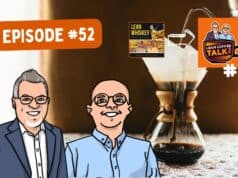 I'm pleased to present the latest in my Lean Thinker Q&A series, this time with Jamie Flinchbaugh, co-author of the recently-published book “The Hitchhiker's Guide To Lean
I'm pleased to present the latest in my Lean Thinker Q&A series, this time with Jamie Flinchbaugh, co-author of the recently-published book “The Hitchhiker's Guide To Lean.” I've known Jamie for many years and have always found him to be very knowledgable and passionate about lean. More importantly, Jamie has been selfless in his willingness to share his lean knowledge. Jamie's full bio can be found here.
We're trying to do this Q&A in “small batch” format, with a few questions that we'll publish each week until we exhaust Jamie's willingness to answer questions, some from me, some from Luke. If you have questions for Jamie about lean or about his book, feel free to post comments on this post or use the Email link on the left to contact me.
——————————-
Q: Jamie, thanks for agreeing to do this Q&A for my blog readers. First, help set the context for your book (with Andy Carlino), “The Hitchhiker's Guide to Lean.” With all of the lean books already published, what was your inspiration to write this one? How do you think this book is different than others? Who are your target readers?
A: There were two inspirations. First of all our clients kept asking us to do so. Secondly, we felt there was something missing. There are many good lean books available, mostly that talked about what lean was and how you might transform a specific process, often in manufacturing. There are many books on tools and practices and many providing perspective from practitioners and leaders. What was missing was the same thing that we were helping our clients understand and apply, many of which are aspects that turn a lean manufacturing initiative into a company transformation. We talk about lean principles, lean leadership, pitfalls in your lean journey, the roadmap for a lean transformation – these are topics that most people either learn the hard way or never learn at all. We felt there was value in sharing some of our experiences with a broader audience that help boost and sustain lean transformation.
Q: You write about systematic problem solving as one of your five core lean principles. From your observation and experience, how successfully have companies been adopting this aspect of a lean culture?
A: Adopting a problem solving culture and practice based on lean, coupled with tools and skills, faces many barriers. First, every organization solves problems, so it is hard for people to appreciate how different it really is. Second, really learning lean problem solving requires both practice and coaching – both things people are not readily investing in. But with lean problem solving you have trouble extending beyond initial gains from lean implementation. Take something seemingly simple such as five S. Now most companies start five S without even getting its purpose right. While all benefits, the purpose of five S is not cleanliness, discipline or organization, or the worst reason of all, being “tour ready.” The purpose is to spot problems quickly. So once I start surfacing problems through five S and other means, I need to use that opportunity effectively. From understanding the problem effectively, to driving to root cause to determining effective countermeasures to sustaining through standardization – there are many opportunities to improve these areas.
Q: I like the way you talk about the need to “hate waste.” How do you work to develop that and teach that to people? What is the role of the consultant as opposed to the role of the lean company's leadership in setting the expectation that waste can't be tolerated?
A: Waste identification and elimination is both an objective and a principle. Too often it is only taught as the rationale for doing other lean things. But it is a behavior, skill and practice itself. Appreciating the waste in your organization requires a new lens, a new pair of glasses, that exposes those opportunities. That lens is the original 7 wastes taught by Taiichi Ohno; they are not just a historical artifact as some would treat them. Someone from outside the organization can teach people how to find the waste and how to eliminate it, and once the individual sees the waste that lays around them all the time, it is quite hard not to begin hating that waste. But sustaining the lens, and sustaining the hatred of that waste, falls on leadership. It can only be done through daily focus and activity. This is why lean leadership is so important, and why lousy leadership is a threat to any organization's sustainability of lean.
Here is Part #2 of the Q&A (3/23/06)
Please scroll down (or click) to post a comment. Connect with me on LinkedIn.
Let’s work together to build a culture of continuous improvement and psychological safety. If you're a leader looking to create lasting change—not just projects—I help organizations:
- Engage people at all levels in sustainable improvement
- Shift from fear of mistakes to learning from them
- Apply Lean thinking in practical, people-centered ways
Interested in coaching or a keynote talk? Let’s start a conversation.










[…] by Mark Graban on March 23, 2006 · 1 comment I’m pleased to present the latest in my Lean Thinker Q&A series, this time with Jamie Flinchbaugh, co-author of the recently-published book “The Hitchhiker’s Guide To Lean.” Here is part #2 of our Q&A, below. Part #1 is here. […]